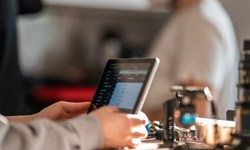Somewhere in the suburbs of London a young man gets home from a night out. Before he hits the hay he grabs his favorite magazine and flips to a page with a beautiful actress on it. He turns the page to face his web cam, and she pops up on screen giggling and telling him a dirty joke.
Across the pond in New York City a mother in her forties is leafing through a fashion magazine. She sees a sweater she likes and holds the ad up to her web cam. She is taken straight to the online checkout, clicks, and buys the sweater.
This is augmented reality, the hottest innovation in the magazine industry, and it’s much more interactive and content-driven than print has ever been. Magazine giants from Esquire to InStyle to Popular Science have all integrated computer-generated images into their issues over the past year. They use movie stars who talk as well as interactive advertising campaigns in fashion spreads that show 360-degree views of the clothes as models prance in front of the reader.
Esquire magazine, always a trendsetter, wanted something groundbreaking for their 2009 “Best and Brightest” issue. “We come up with these ideas by actively scouring the world for cool new opportunities,” said David Granger, Esquire’s Editor in Chief. “We meet with vendors of all kinds—ink, paper, new technology companies—and occasionally something wonderful comes of these meetings. It’s a lot of work, but it can make a big impact.”
So they called Benjamin Palmer, the CEO of The Barbarian Group digital design firm.
Palmer knew just what Esquire needed.
“We suggested augmented reality as something that would make the reading experience more digital without just giving straight Internet content,” Palmer said. “It’s more than just a showcase of the technology. It’s something pretty deep. It was a really interesting experiment.”
“We are trying to create something that isn’t just about showing off the technology, but actually adds value to the story” explained Palmer.
The company actually built a custom program to produce the multimedia issue, which combines animation, graphics, and video. “There’s no Microsoft Word or Photoshop for augmented reality,” Palmer said. “We spent a lot of time building custom tools.” The company eventually plans to release the program, called Cinder, to the public.
Esquire is not the only glossy to go augmented.
InStyle’s holiday issue is also packed with interactive content, most prominently featured in the magazine’s advertising section.
The magazine’s use of augmented reality allowed for interactive ads which included video advertisements, and a click-to-buy functionality that readers could use to purchase the products in the magazine.
“It’s important to know that this stuff is not just theoretical,” said Ariel Foxman, InStyle managing editor. “In an incredibly tough economy, our ads were up 3.6 percent. This issue performed incredibly well on the newsstand, and overall, this technology created an undeniably strong package for both our readers and our advertisers.”
InStyle is the first women’s fashion magazine to use AR, and also used the technology on their cover, which featured Taylor Swift.
“It’s really easy to do a mediocre version of what AR is,” says Palmer. “But there’s something else that people are trying to do with this hybrid media, which is to make legitimate use of the technology. If people do a bunch of lame stuff, [augmented reality] will just be a fad. If we in the industry do something that resonates, it will be more permanent.”
WHAT IS AUGMENTED REALITY
According to Wikipedia, augmented reality is a term for a live direct or indirect view of a physical real-world environment whose elements are merged with (or augmented by) virtual computer-generated imagery - creating mixed reality. The augmentation is conventionally in real-time and in semantic context with environmental elements, such as sports scores on TV during a match. With the help of advanced AR technology (e.g. adding computer vision and object recognition) the information about the surrounding real world of the user becomes interactive and digitally usable. Artificial information about the environment and the objects in it can be stored and retrieved as an information layer on top of the real world-view.
HOW IT WORKS
The Barbarian Group developed a set of customized tools to effectively combine and create Esquire’s augmented reality issue. Programmed in C++ code (the same coding used to build video games), the company essentially built its own program to make AR happen. The augmented reality content is activated by downloading the plug-in software from the magazine’s website and holding the page in question up to a web cam. The content then automatically opens on your screen.
THE COOLEST THING
One of the greatest things about the use of augmented reality by Esquire was that it actually enhanced the magazine’s content. Where was this enhancement most tangible? The biggest hit was the fashion spread which featured the model walking and moving in the clothing, as well as switching up his clothes to show how all the separate items looked together. That’s something you could never get otherwise.










